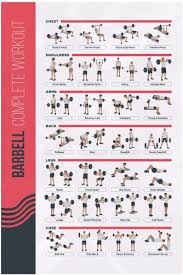The Benefits of Barbell Workouts for Strength Training
Barbell workouts are a popular form of strength training that can help individuals build muscle, increase strength, and improve overall fitness levels. Using a barbell allows for compound movements that engage multiple muscle groups simultaneously, making it an efficient and effective way to work out.
Key Benefits of Barbell Workouts:
- Increased Muscle Mass: Barbell exercises like squats, deadlifts, and bench presses target major muscle groups, stimulating muscle growth and development.
- Improved Strength: Regular barbell training can lead to significant strength gains in various muscle groups, enhancing overall physical performance.
- Enhanced Stability and Balance: Barbell exercises require core stabilization and balance control, leading to improved stability and coordination.
- Better Bone Health: Weight-bearing barbell exercises help strengthen bones, reducing the risk of osteoporosis and improving bone density.
- Efficient Workouts: With a barbell, you can perform a wide range of exercises targeting different muscle groups without the need for multiple machines or equipment.
Tips for Effective Barbell Training:
- Proper Form: Focus on maintaining proper form throughout each exercise to prevent injuries and maximize results.
- Progressive Overload: Gradually increase the weight lifted to continually challenge your muscles and promote growth.
- Rest and Recovery: Allow adequate rest between workouts to give your muscles time to repair and grow stronger.
- Variety in Workouts: Incorporate different barbell exercises into your routine to target various muscle groups and prevent plateaus.
In conclusion, barbell workouts offer numerous benefits for individuals looking to improve their strength, muscle mass, and overall fitness levels. By incorporating barbell exercises into your training routine with proper form and technique, you can achieve significant results in your fitness journey.
9 Essential Tips for a Safe and Effective Barbell Workout
- Warm up properly before starting your barbell workout.
- Focus on proper form and technique to prevent injuries.
- Start with lighter weights to master the movements before increasing the load.
- Incorporate compound exercises like squats, deadlifts, and bench press for full-body strength.
- Ensure adequate rest between sets to maximize muscle recovery.
- Gradually increase the weight as you get stronger to continue challenging your muscles.
- Listen to your body and don’t push through pain – stop if something doesn’t feel right.
- Stay hydrated throughout your workout session.
- Cool down and stretch after your barbell workout to improve flexibility and reduce muscle soreness.
Warm up properly before starting your barbell workout.
Properly warming up before starting your barbell workout is crucial for preparing your muscles and joints for the upcoming intensity. A good warm-up routine can help increase blood flow, raise body temperature, and improve flexibility, reducing the risk of injuries during your workout. By incorporating dynamic stretches, light cardio exercises, and specific movements targeting the muscles you’ll be working, you can enhance your performance and get the most out of your barbell training session. Remember, a thorough warm-up sets the foundation for a safe and effective workout experience.
Focus on proper form and technique to prevent injuries.
Focusing on proper form and technique during barbell workouts is crucial to prevent injuries and maximize the effectiveness of your training. By maintaining correct posture and alignment, you not only reduce the risk of strains or sprains but also ensure that the targeted muscles are being properly engaged. Paying attention to form allows for a more efficient workout, helping you achieve your fitness goals safely and effectively.
Start with lighter weights to master the movements before increasing the load.
When embarking on a barbell workout regimen, it is essential to begin with lighter weights to focus on mastering the movements and techniques before progressing to heavier loads. By starting with lighter weights, individuals can ensure proper form, alignment, and muscle engagement during each exercise. This approach not only reduces the risk of injury but also allows for a solid foundation to be established before gradually increasing the load. Mastering the movements with lighter weights sets the stage for safe and effective strength training progression in the long run.
Incorporate compound exercises like squats, deadlifts, and bench press for full-body strength.
Incorporating compound exercises such as squats, deadlifts, and bench press into your barbell workout routine is essential for achieving full-body strength and muscle development. These multi-joint movements engage multiple muscle groups simultaneously, providing a comprehensive workout that targets major muscle groups in the lower body, back, chest, and arms. By including these compound exercises in your training regimen, you can improve overall strength, enhance muscle coordination, and boost functional fitness for a well-rounded and effective workout routine.
Ensure adequate rest between sets to maximize muscle recovery.
Ensuring adequate rest between sets during a barbell workout is crucial for maximizing muscle recovery and overall performance. Giving your muscles enough time to rest allows them to replenish energy stores, repair damaged tissue, and grow stronger. Without proper rest intervals, fatigue can set in, leading to decreased exercise performance and potential injury risk. By prioritizing rest between sets, you can optimize muscle recovery, enhance workout effectiveness, and ultimately achieve better results in your strength training regimen.
Gradually increase the weight as you get stronger to continue challenging your muscles.
Gradually increasing the weight as you get stronger is a key tip in barbell workouts to ensure continuous muscle growth and development. By challenging your muscles with progressively heavier weights, you stimulate further strength gains and prevent reaching a plateau in your training progress. This approach not only helps you build muscle mass effectively but also enhances your overall strength and fitness levels over time. Remember, consistent progression in weightlifting is essential for maximizing the benefits of your barbell workout routine.
Listen to your body and don’t push through pain – stop if something doesn’t feel right.
It is crucial to listen to your body during barbell workouts and prioritize safety over pushing through pain. If something doesn’t feel right or if you experience discomfort beyond normal muscle fatigue, it is important to stop the exercise immediately. Ignoring pain signals can lead to injuries that may hinder your progress and overall well-being. Always pay attention to how your body responds to each movement and adjust accordingly to ensure a safe and effective workout experience.
Stay hydrated throughout your workout session.
It is crucial to stay hydrated throughout your barbell workout session to maintain optimal performance and prevent dehydration. Sweating during exercise causes fluid loss, and replenishing this fluid by drinking water helps regulate body temperature and supports muscle function. Adequate hydration also aids in the transportation of nutrients to muscles and the removal of waste products, promoting overall workout efficiency and recovery. Remember to sip water regularly before, during, and after your barbell workout to stay hydrated and energized throughout your training session.
Cool down and stretch after your barbell workout to improve flexibility and reduce muscle soreness.
After completing your barbell workout, it is essential to incorporate a cool down and stretching routine to enhance flexibility and alleviate muscle soreness. Cooling down allows your heart rate to gradually return to its resting state, while stretching helps lengthen and relax the muscles that were engaged during the workout. By dedicating time to cool down and stretch post-barbell session, you can improve your overall flexibility, reduce the risk of injury, and promote faster muscle recovery. This simple yet effective practice can contribute to better performance in future workouts and support your long-term fitness goals.


